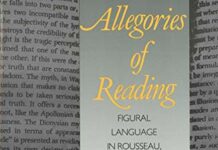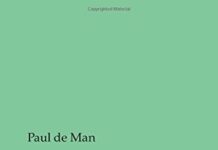
Ebook Info
- Published: 1986
- Number of pages: 137 pages
- Format: PDF
- File Size: 8.75 MB
- Authors: Paul de Man
Description
The title essay in this book does not engage in a debate with the polemical opponents of literary theory; to Paul de Man, the resistance to theory is inherent in the theoretical enterprise itself, and the real debate is with its own methodological assumptions and possibilities.
User’s Reviews
Reviews from Amazon users which were colected at the time this book was published on the website:
⭐I have no idea who the other reviewer of this brilliant book is. All I can say is that his last name, the first syllable of it, speaks for itself. Don’t listen to me. Read the book and see for yourself. I met de Man in 1976. He was the most intelligent man I have ever met.
⭐Yale University commissioned Paul de Man to write an essay on literary criticism to be published in the 1982 volume of Introduction to Scholarship in Modern Languages and Literatures. The editors did not like de Man’s assertion that “the main theoretical interest of literary theory consists in the impossibility of its definition.” They wanted an essay that would spell out a definition and when he threw in the word “impossible” they rejected his paper. Surprisingly, de Man was not upset since he felt that he had indeed addressed the parameters required by the editors that he focus on the general origin of recent American literary criticism. Eventually, de Man included the essay in a series of essays that he published in 1986 using the same name as the essay itself–The Resistance to Theory. Crucial to understanding de Man’s essay is having a general idea of the state of literary theory beginning with the popularization of deconstruction by Jacques Derrida in the mid 1960s. Prior to Derrida, the generally accepted mode of discourse was couched in the New Criticism, which required critics to focus only on the words on the page with no attention to be placed on ideology, history, or autobiography.Derrida’s theory of deconstruction was based on the premise that all texts contained within themselves the seeds of their own subversion. All a critic had to do to “deconstruct” a text was to identify a few binaries (opposites) and then swap their positions on the slash, thus uncovering a supposedly “hidden” meaning. De Man was entranced with what he saw as a novel method to analyze texts. He quickly saw that deconstruction had application to fields outside literature. In the ability of deconstruction to “cloud” the meaning of any text, any text or act could be obfuscated, deferred, or excused. Years later, when documents written by de Man in 1941 and 1942 during World War II were revealed indicating his blatant anti-Semitism, de Man and his supporters could use the exculpatory logic of deconstruction to shift blame away from de Man. It is hardly surprising that de Man became an early and ardent champion of deconstruction. Those who read de Man’s essay today unconsciously assume that his use of the word “theory” refers to the theory of deconstruction. This mention of theory is no more than a linguistic red herring, designed to draw the attention of the reader away from the term’s original definition, context, and use. Deconstruction as a theory is more anti-theory than theory itself. To understand why one must note that theory acquired its mid-twentieth century connotation of close reading, activity of analysis, and a willingness to consider new ideas when old ideas were demonstrably proven to be ineffective. The New Critics set the tone for the meaning of theory as consistent with the belief that the words of a text held definite referential meaning that a critic could uncover after utilizing a variety of methods that involved examining a myriad of techniques, a very few of which would be accepted but most not. It would never occur to this sort of traditional theorist that one size fitting each theory could be used on all texts using the same method of seeking subversion, paradox, and reversal of polar binaries. John Ellis, in Against Deconstruction suggests that the inevitable result of using such a one note technique would be a movement from a higher and more complex meaning of the original to a lower level of complexity in the deconstructed text. What caused the very definition of theory to change from a belief that many modes of analysis had to be weighed and evaluated to another belief that the single act of swapping of sides on the slash of a binary would reveal the “hidden” meaning was the introduction of French thought and vocabulary beginning with Derrida and continuing with de Man. This infusion of French thought was an offshoot of social, political, and cultural changes that began in France in the mid 1960s and quickly spread to the United States where American university departments of literature were instrumental in funnelling such ideas into mainstream American thought. The word “theory” then assumed the cachet of elitist philosophy that became inextricably aligned with leftist ideology. Each time that de Man uses the word “theory” he does not refer to it in the old way of a variety of techniques used to analyze text; rather he uses it as a synonym for deconstruction. Hence, opposition to deconstruction was “resistance to theory.” Ironically, when de Man notes that this resistance to theory emanates from theory, Ellis charges de Man with being the true source of resistance. De Man egotistically notes that “literary theory can be said to come into being when the approach to literary texts is no longer based on non-linguistic, that is to say historical and aesthetic considerations.” By “literary theory” he means only the deconstructive mode as if all other previous modes were suddenly rendered obsolete or never having existed. De Man was able to tap into the linguistic theories of Ferdinand de Saussure which de Man felt would be instrumental in deferring or permanently removing one of the foundations of Western thought–that there exists a series of eternally fixed concepts that served as philosophical centers of meaning. Deconstructive logic absolutely precluded the possibility that a “center” could exist in discourse. When Saussure’s linguistic sign paradigms were applied to texts, the result, according to de Man, would be to render the concept of a referent as “epistemologically highly suspect and volatile.” De Man saw literature and language as fatally flawed by their very reliance on rhetoric and literary tropes, both of which may communicate only aesthetic qualities like enjoyment, excitement, and emotion but were sadly unable to furnish anything resembling eternal verities of the sort that both Derrida and de Man were insistent were non-existent. De Man also suggests that the definition of “literariness” ought to change to reflect deconstructive thought. The original definition (pre-deconstruction) usually was mentioned in the context of aesthetics and mimetics. Theoreticians who still clung to such “outmoded” notions as referentiality and transcendental signifieds were to be seen as opponents or resistors to theory. De Man’s double use of “theory” (the original and his own) was a perfect example of how deconstructive tenets could be applied to marginalize dissenters. Theory and literature share a common structure; both use words, images, and tropes to develop ideas and consequently are vulnerable to the same irritating issues of methodological assumptions and possibilities. Thus, what causes literature to be susceptible to misreading also applies to theory. Since reading literature inevitably leads to misreading it, then the same can be said of misreading theory. The flaw in reading theory is not extrinsic to theory. Rather the flaw is intrinsic: “Nothing can overcome the resistance to theory since theory is itself this resistance.” De Man distinguishes theorizing from theory. The former suggests an ongoing series of mental cerebrations that often oppose the basic concept. Hence the resistance to theory is theory itself. The latter suggests that it is merely a starting point using concepts, methods, and terminology gained from sources outside itself, which also unsurprisingly lead one to conclude that the resistance to theory never ends since such resistance must come from the eternal squabble between theorizing and theory. “The Resistance to Theory” ultimately emerges as a self-serving exercise in the use of a literary red herring. The more that one becomes entranced with the pseudo-elitist concepts that promise much but deliver little, the more that Paul de Man has succeeded in setting up a theory that allows him to escape from the dreadful consequences of some essays that he wrote in the 1940s that he hoped would never come to light.
⭐死後に出た本で『ロマン主義のレトリック』『美学イデオロギー』に分散されている晩年の連続講演のうち最後のベンヤミン論と対談が最後に載せられているすべての概念の基盤である確実性の概念そのものが、ヘーゲルにおけるような無媒介の確信であれ、デカルトにおけるような間接的な妄想であれ、感覚的な経験との関係においてのみ生じるものであるからだ。もしも意識(あるいは経験、心、主体、言説、顔)が存在するとしたなら、それは現象化が可能でなければならない。しかし、経験の現象性はア・プリオリに確立できるものではなく、意味作用の過程によってのみ生起しうるのである。意味するものの現象的、感覚的属性は、意味されるものが、究極的には指示対象が、たしかに存在することの保証とならねばならない。106エロティックなものは、感覚体験の高揚したかたちというよりは、むしろそうした経験を可能にする比喩表現である。われわれは愛するものを見るのではなく、なにものかを見ているのだという幻想を確認したいがゆえに愛するのである。116美的な力を意志の道具として鋭く意識しているニーチェは、警告する。快あるいは苦痛に基づく判断は、「想像しうる限り最も馬鹿げた判断の表現である。もちろん私[ニーチェ]は、だからといって、そのような仕方の判断が間違いなく馬鹿げていると言っているのではないが」。美的反応は中心的原因とはみなしえず、些細な副作用と考えるしかない。「それは中心的で支配的な価値から派生した二義的な価値判断であり、また害益を純粋に感情的な仕方で考えるがゆえに、絶対的に不安定で依存的なのである」。歴史家や批判哲学者に美的反応が少なからぬ関心を呼び起こすというのは、体系的であるというよりも散発的なものであり、その誤謬をもたらす力が他の原因の存在を教えてくれるかぎりにおいて、哲学的に意味を持つのである。135ヘーゲルが美的なものを暫定的な認識形式と論じたことは、多くの誤解を招いてきたが、それはキルケゴールとニーチェという彼の後継者の精神にも見られるのである。このことはとりわけ、美的なるものが明晰と制御へつながるものとして引き合いに出されるときにはいつも、別な言葉でいうなら、ある症候がそれによって示される病気の治療手段に変えられてしまうときにはいつも、おおいに警戒する必要があることを意味する。135
⭐
Keywords
Free Download Resistance To Theory (Volume 33) (Theory and History of Literature) in PDF format
Resistance To Theory (Volume 33) (Theory and History of Literature) PDF Free Download
Download Resistance To Theory (Volume 33) (Theory and History of Literature) 1986 PDF Free
Resistance To Theory (Volume 33) (Theory and History of Literature) 1986 PDF Free Download
Download Resistance To Theory (Volume 33) (Theory and History of Literature) PDF
Free Download Ebook Resistance To Theory (Volume 33) (Theory and History of Literature)

